Beaver Facts & Behavior
If you live in an area where beaver control is a necessary wildlife management tool, it will be important for you to understand beaver behavior, as well as, what they can do to your surroundings, because this will impact how you control both current and future beaver related issues.
Understanding Beaver Wildlife
Beavers are very interesting animals, understanding beaver behavior is helpful tool when it comes to controlling them and the damage they can do. We've got some helpful information for you on beaver dams (benefits and hazards), lodges, habitats, family life, and humane methods of beaver control.
Beavers And Beaver Dams - Benefits And Hazards
Beavers are large rodents that make their homes, in the form of dams, in waterways such as creeks, rivers, mountain streams, ponds, and even along the shorelines of large lakes. Beavers are brilliant engineers designing and building dams that can become very large in size - large enough to impact the environment and surroundings around them.
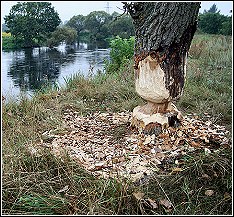
At times, beaver dams can be beneficial to the environment. For instance, beaver dams can sometimes help prevent erosion and flooding, and the activities of beavers can be a vital component in maintaining the balance of delicate ecosystems such as wetland, mountain and forest environments. However, at other times beaver activities and dams can become quite problematic, for example, beavers can destroy valuable trees, and dams can cause water blockage, flooding or erosion in unwanted areas. The photos of the dams shown below were taken by Wildlife Whisperer Ned Bruha during a beaver control mission.
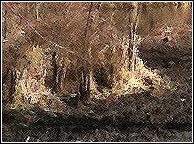
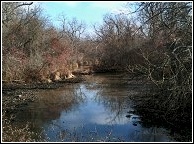
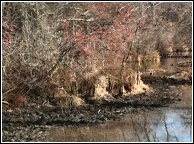
Interesting Facts About Beavers
Beavers are nocturnal animals that feed on plants such as vegetables, berries and tree bark. Beavers are not a fish, reptile or amphibian, but rather they are a mammal. Just the same, beavers are built for life in the water – their coats are warm and water repellant, their tails serve as a rudder and they have large capacity lungs which allow them to hold their breath underwater for a very long time.
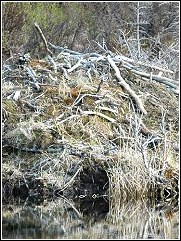
Beavers are built for another function too, that of dam builder. Their broad flat tail serves as a mud packing tool and their large sharp teeth enable them to cut down trees, sculpt lumber, carry wood and build dams.
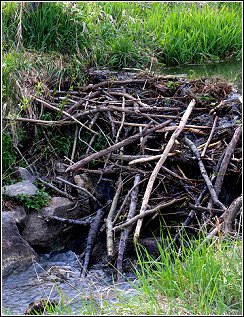
Beavers build dams mainly in an attempt to create a more optimal habitat in which to live. For instance, damming up a creek may create a larger, deeper, calmer water source – in other words, an environment more to their liking. Ironically, beavers are attracted to the sound of running water, perhaps because they enjoy building dams that will stop it’s flow. Beavers reside in homes they create called lodges. These are large, rounded, mound like structures made up of sticks, logs, mud and leaves. A beaver lodge like the one shown just above in Denali National Park Alaska, is usually part above and part below water with several entries and exits including underwater entrances. Beaver tree preferences include fast-growing trees, such as poplar, willow, cottonwood and alder located close to the shoreline. Although the beaver handiwork and felling of trees may appear destructive, such pruning can actually result in more, bushier growth when spring arrives. For example, each cut willow stem can lead to three to four new stems. If the beavers then use the branches for a dam that creates a wetland, great benefits can result, such as erosion abatement, area flood control, water cleansing and beneficial biodiversity.
North American Habitat
The beaver's North America habitat stretches from southern Alaska, through Canada and even as far south as Florida.
Beavers were once hunted to dwindling numbers for their luxurious fur, but have since made a comeback in the last 50 years. According to a very interesting University report on beavers, the beaver population in one state has increased from a 1952 figure of 485 beavers limited to a west central area of the state to thousands today, distributed throughout the state with resident beavers in every county.
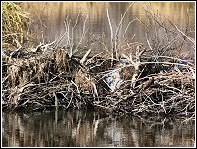
Beaver Family Life
Beaver family life includes one litter per year, averaging between two to four babies, also known as “kits”. Juvenile beavers usually leave in the spring around the age of two to create a home of their own.
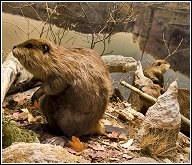
Beavers are adept at keeping populations at just the right level. When an area becomes too populous reproductive rates begin to decline, likewise, beavers tend to produce larger litters when numbers begins to dwindle. This is an important concept to understand when deciding on a beaver control plan for your property and surrounding area. It is also one of the reasons why beaver trap methods are merely temporary and why trapping practices will actually do little to solve your beaver problems. Trap one beaver and another one will soon show up to takes it’s place.
When it comes to successful beaver control methods, fully understanding beaver behavior including lodge creation, tree felling skills, dam building practices, reproduction habits and the impact of beavers on the environment, is key to designing beaver management techniques that are both effective and humane too.
Beaver Management The Humane Way
A detailed look at humane beaver control methods including products and techniques to protect trees, environmental tree management and planting recommendations, repellant products with reported success and helpful beaver habitat modifications. And again, a look at why traditional beaver trapping methods are not an effective solution to beaver problems.
1242 SW Pine Island Rd., Suite 310
Cape Coral, Florida 33991-2126
help@totalwildlifecontrol.com














